What You Need to Know About Japan’s Most Neat Raw Fish Dish
Sashimi is a traditional Japanese dish consisting of thinly sliced raw fish or meat served without rice. Unlike sushi, which always includes vinegared rice, sashimi showcases the pure flavor and texture of premium seafood in its most natural form.
Quick Sashimi Facts:
- Definition: Raw fish or meat sliced thin and served alone
- Origin: Ancient Japanese fishing technique meaning “pierced body”
- Common Types: Tuna (maguro), salmon (sake), yellowtail (hamachi)
- Serving: Arranged on shredded daikon with wasabi and soy sauce
- Safety: Requires sashimi-grade fish, properly frozen to kill parasites
For food-loving travelers, sashimi represents the pinnacle of Japanese culinary artistry. Every slice demands perfect knife skills, absolute freshness, and deep respect for the ingredient’s natural qualities.
The dish traces back centuries to Japanese fishing communities. Fishermen would pierce caught fish through the brain using a technique called ikejime to preserve quality. This “pierced body” method gave sashimi its name and established the foundation for today’s meticulous preparation standards.
Modern sashimi goes far beyond basic raw fish. You’ll find everything from buttery tuna belly (otoro) to sea urchin (uni) to surprisingly tender octopus. Some regions even serve thin-sliced raw meats like horse (basashi) or lightly seared tataki-style preparations.
Whether you’re planning a trip to Tokyo’s Tsukiji market or attempting homemade sashimi, understanding this neat dish opens doors to authentic Japanese dining experiences.
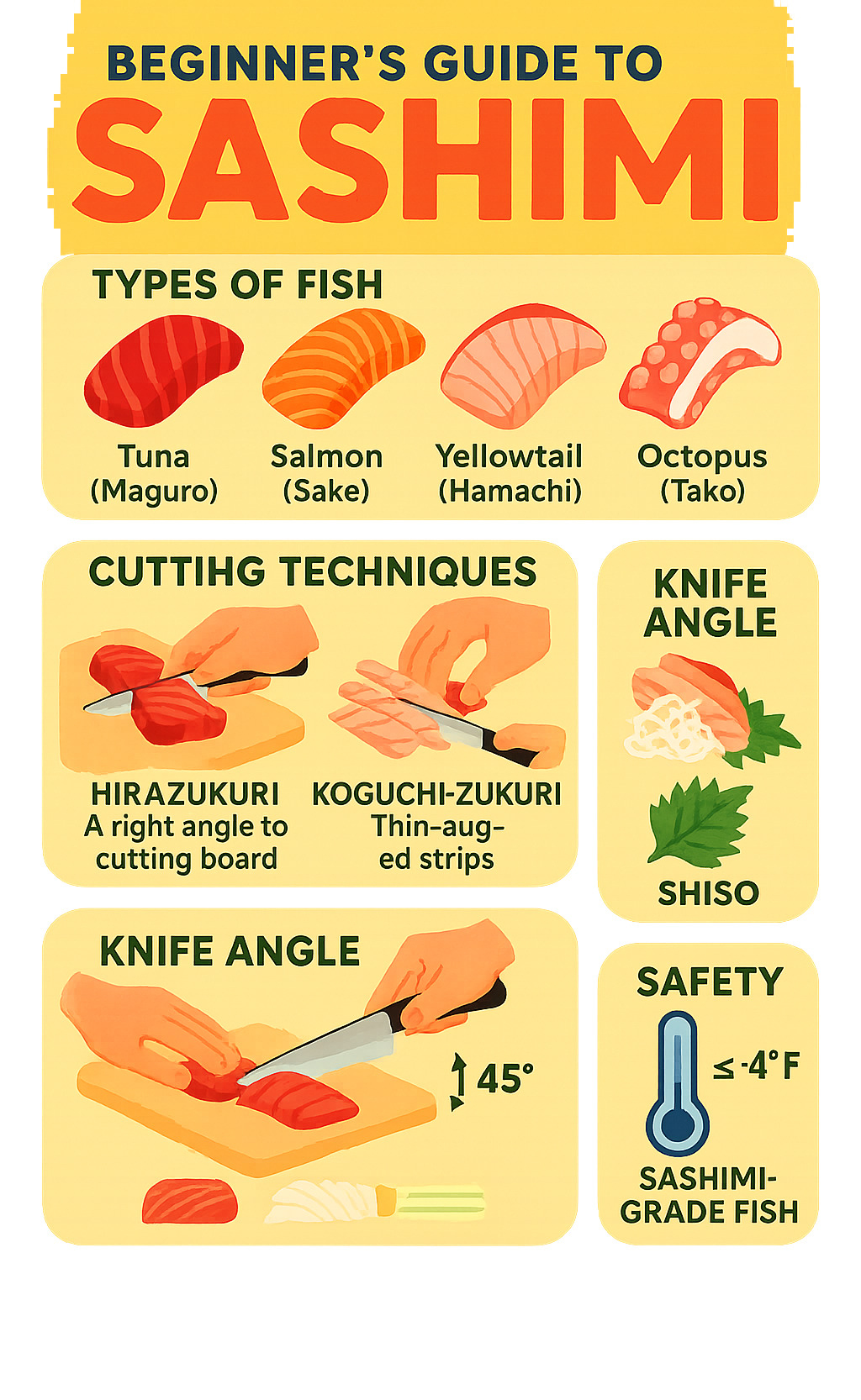
What Is Sashimi? History, Meaning & Core Ingredients
The word sashimi carries a surprisingly practical origin story. It literally means “pierced body” in Japanese, referring to an ancient fishing technique that’s still used today. When fishermen catch premium fish, they immediately pierce the brain using a method called ikejime. This quick action stops the nervous system instantly, preventing stress chemicals from affecting the meat and keeping the fish fresh for up to ten days on ice.
Here’s where history gets interesting. During Japan’s Muromachi period (1336-1573), samurai culture shaped even how people talked about food. The word “kiru” (meaning “to cut”) was considered taboo among warriors, so “sashimi” became the preferred way to describe this beautifully sliced delicacy.
Sashimi has grown far beyond its fish-only roots. While tuna, salmon, and kingfish dominate most restaurant menus, adventurous diners can find raw horse meat called basashi in certain regions. Even vegetarians aren’t left out – delicate yuba tofu skin is often prepared sashimi-style, showcasing the same precise knife work and artistic presentation.
The traditional ikejime technique remains the gold standard for premium sashimi preparation. Modern chefs still prize fish processed this way above all others because it preserves the clean, pure flavors that make great sashimi unforgettable.
The Evolution of Sashimi Through the Centuries
Sashimi transformed from a practical fishing village meal into high culinary art over several centuries. The real turning point came during the Edo period (1603-1868), when Tokyo’s fish markets became incredibly sophisticated. Fishmongers developed expert knowledge about which species worked best raw and how to spot peak quality at a glance.
Interestingly, samurai culture created some unusual taboos around raw fish consumption. Some warrior classes avoided certain preparations, believing they affected spiritual purity. These cultural restrictions actually helped refine sashimi techniques as chefs found creative ways to work within social expectations.
The Edo fish markets became legendary for their freshness standards and specialized knowledge. Vendors would wake before dawn to select the finest catch, and their reputations depended entirely on consistent quality. This competitive environment pushed sashimi preparation to new heights of precision.
Global spread began in earnest during the 1860s when Western visitors first documented their experiences with this “peculiar” delicacy. While early reactions were mixed, the foundation was laid for sashimi’s eventual worldwide popularity. Today’s international fusion preparations often blend traditional Japanese techniques with local flavors and modern presentation styles.
Common Species Used for Sashimi
Understanding different fish types makes ordering sashimi much more enjoyable and less intimidating. Each species offers unique flavors and textures that showcase why this dish has captivated food lovers for centuries.
Maguro (tuna) reigns as the king of sashimi. Regular maguro delivers clean, meaty flavor that’s perfect for beginners. The real magic happens with the fatty belly cuts – chutoro (medium fat) and otoro (highest fat) offer buttery richness that literally melts on your tongue.
Sake (salmon) might surprise you with its relatively recent arrival in Japanese cuisine. Norwegian imports in the 1980s introduced this now-beloved variety. Farm-raised salmon is actually safer than wild varieties, since proper aquaculture eliminates the roundworm larvae found in all wild salmon.
Hamachi (yellowtail) provides rich, buttery flavor with incredibly smooth texture. Winter hamachi, called buri, tastes even more intense due to higher fat content during cold months. It’s often considered the perfect middle ground between lean and fatty fish.
Hirame (flounder) represents the delicate side of sashimi. This white fish actually improves with a few days of careful aging after catch, developing deeper flavors while maintaining its tender texture. Its mild taste makes it ideal for sashimi newcomers.
Ika (squid) offers something completely different – a firm, almost crunchy texture despite being raw. When cut into thin strips called “ika somen,” it resembles noodles and provides a fun textural contrast on mixed platters.
Uni (sea urchin) divides people like no other sashimi. These orange-yellow lobes offer intense oceanic flavor that ranges from sweet and creamy (premium quality) to bitter and unpleasant (poor quality). Quality makes all the difference with uni.
Ikura (salmon roe) technically isn’t raw fish, but these pea-sized orange spheres frequently appear on sashimi platters. They burst with salty-sweet flavor that adds both visual appeal and taste complexity to any arrangement.
Sashimi vs. Sushi & Other Raw Dishes
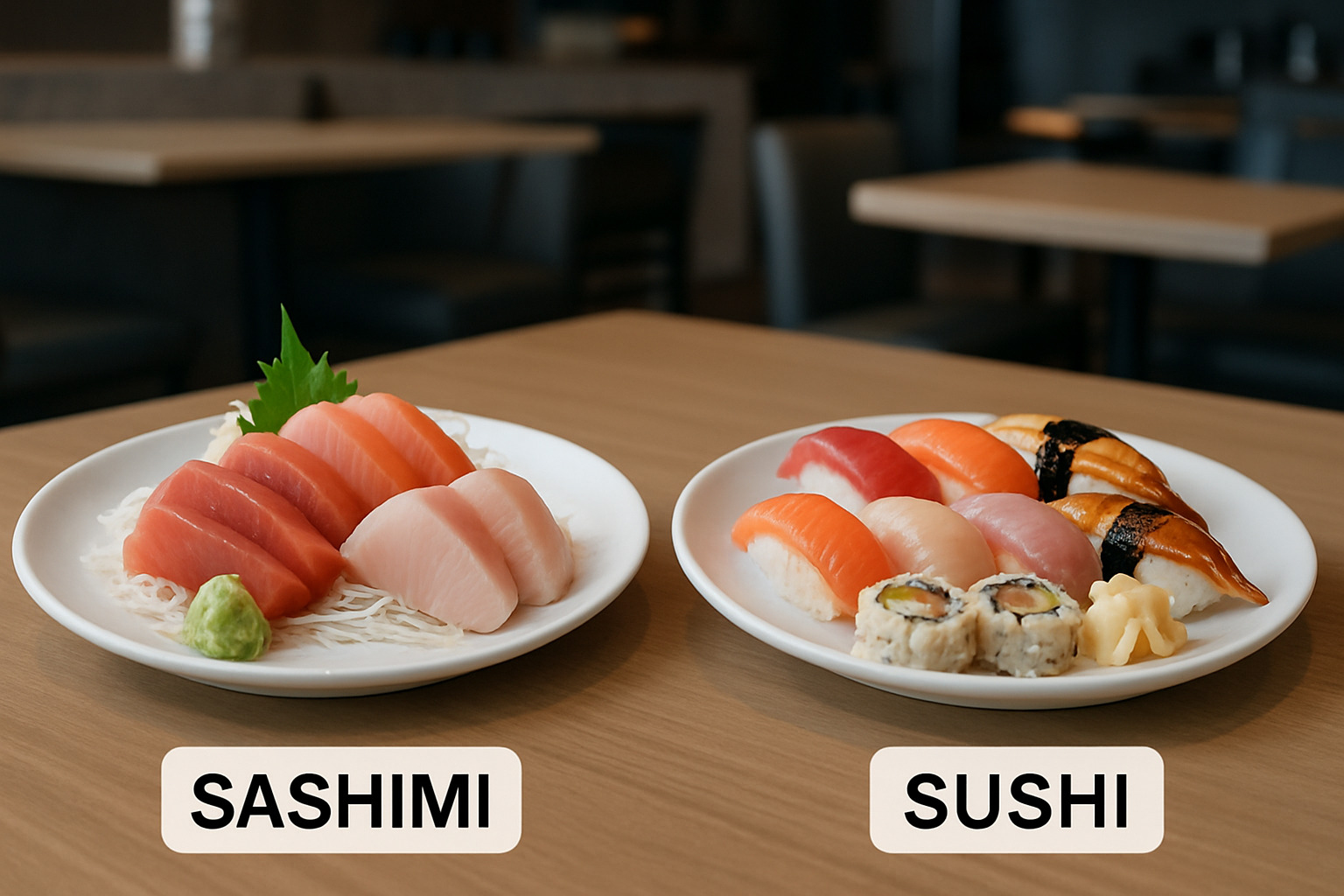
Here’s the thing that confuses almost everyone: sashimi and sushi aren’t the same dish at all. Yes, they both feature raw fish, but that’s where the similarities end. Think of it like comparing a steak to a hamburger – same main ingredient, completely different experience.
The rice is everything when it comes to understanding this difference. Sushi always, always includes specially prepared vinegared rice called shari. This rice gets seasoned with rice vinegar, salt, and sugar to create that distinctive tangy-sweet flavor. Even those cucumber rolls with no fish? Still sushi because of the rice. Sashimi stands alone – no rice, no fillers, just pure fish in all its glory.
Now, sashimi isn’t the only raw fish game in town. Around the world, different cultures have created their own takes on uncooked seafood. Ceviche from Peru “cooks” the fish using citrus acid, giving it a completely different texture and bright, zesty flavor. Tiradito combines Peruvian and Japanese techniques, taking sashimi-style cuts but adding citrus and aji peppers for heat.
French tartare goes in a totally different direction, chopping or mincing the fish and mixing it with capers, herbs, and other seasonings. Tataki offers an interesting middle ground – the fish gets quickly seared on the outside while staying raw inside, then sliced just like sashimi.
| Dish | Origin | Key Ingredients | Preparation Method |
|---|---|---|---|
| Sashimi | Japan | Raw fish/meat, soy sauce, wasabi | Precise knife cuts, no seasoning |
| Sushi | Japan | Raw/cooked fish, vinegared rice | Rice forms the base |
| Ceviche | Peru | Raw fish, citrus acid, onions | Fish “cooked” in acid |
| Tiradito | Peru-Japan fusion | Raw fish, citrus, aji peppers | Combines sashimi cuts with Peruvian flavors |
| Tartare | France | Raw beef/fish, capers, herbs | Chopped/minced texture |
Key Differences in Preparation & Presentation
What makes sashimi special isn’t just what it is – it’s how it’s prepared and when you eat it. Unlike other raw fish dishes that rely on acids, spices, or sauces to transform the fish, sashimi takes the opposite approach. The goal is to showcase the fish exactly as nature made it.
Timing matters more than you might think. In traditional Japanese meals, sashimi always comes first, before your taste buds get overwhelmed by stronger flavors. This isn’t just tradition – it’s smart eating. Once you’ve had miso soup or tempura, you’ll miss the subtle differences between a piece of yellowtail and sea bream.
The seasoning philosophy couldn’t be more different from dishes like ceviche. While Peruvian preparations use lime juice to actually change the fish’s texture and flavor, sashimi keeps things minimal. You get a tiny dish of soy sauce and a dab of wasabi, applied only at the moment you eat each piece.
Presentation follows centuries-old rules that turn your plate into edible art. The fish gets arranged to create visual balance through color contrasts and height variations. Those garnishes aren’t just pretty – the shredded daikon radish and shiso leaves actually cleanse your palate between different fish types.
Cutting Techniques That Define Sashimi
Here’s where sashimi becomes a true art form. The way a chef cuts the fish completely changes how it tastes and feels in your mouth. These techniques take years to master, and each one serves a specific purpose.
Hira-zukuri is what most people picture when they think sashimi – those neat rectangular slices about 10mm thick. This technique works perfectly for firm fish like tuna and yellowtail, creating substantial pieces that let you really experience the fish’s natural texture.
For delicate white fish like flounder or the famous (and potentially deadly) blowfish, chefs use usu-zukuri. These paper-thin slices, only 2mm wide, make tough fibers much easier to chew. It’s like the difference between biting into leather and silk.
Kaku-zukuri goes the opposite direction, creating chunky 20mm cubes that work beautifully with ultra-fresh, tender fish. When you bite into these pieces, you get the full impact of the fish’s texture and flavor.
Then there’s ito-zukuri, which creates thread-like strips thinner than angel hair pasta. Squid sashimi often gets this treatment, earning the nickname “ika somen” because it looks just like fine noodles.
None of this would be possible without the yanagiba knife – a razor-sharp, single-bevel blade that’s typically 240-300mm long. This knife lets chefs slice through fish in one smooth motion without tearing the delicate flesh. The clean cuts preserve the fish’s cellular structure and prevent it from losing moisture, which is why properly cut sashimi has that perfect, almost bouncy texture.
Choosing & Preparing Sashimi-Grade Fish at Home
Creating sashimi at home feels intimidating, but it’s absolutely achievable once you understand the safety requirements and sourcing secrets. The key lies in finding truly sashimi-grade fish and following proper handling techniques that professional chefs have used for centuries.
Here’s something that might surprise you: fresh doesn’t always mean safe for raw consumption. That beautiful salmon at your local supermarket might look perfect, but it could harbor dangerous parasites. A comprehensive study from Seattle found that 100% of wild salmon contained roundworm larvae capable of making you seriously ill, while properly managed farm-raised salmon showed zero contamination.
The freezing process is your safety net, not a compromise on quality. The FDA requires fish destined for raw consumption to be frozen at -35°C (-31°F) for 15 hours, or at -20°C (-4°F) for seven full days. European Union regulations allow 24 hours at -20°C. These specific temperatures kill anisakis roundworms and other parasites that can cause severe digestive problems.
When you’re examining potential sashimi fish, your senses become powerful quality detectors. Bright, clear eyes signal freshness, while cloudy or sunken eyes indicate the fish is past its prime. Gills should show brilliant red color rather than brown or gray, and the flesh must feel firm and spring back when you press it gently.
The smell test never lies. Quality fish smells clean and oceanic, almost like a fresh sea breeze. If you detect any “fishy” odors or hints of ammonia, walk away immediately. That’s your nose warning you about bacterial breakdown.
Modern flash-freezing technology actually preserves *sashimi quality better* than many “never frozen” alternatives. The rapid freezing process locks in texture and flavor while eliminating health risks. Don’t let marketing claims about “fresh” fish override your safety priorities.
Where to Buy and What “Sushi-Grade” Really Means
The term “sushi-grade” has no legal definition, which makes it both confusing and potentially misleading. However, reputable suppliers use this designation to indicate fish that meets specific handling and freezing standards required for raw consumption.
Specialty fishmongers represent your best option for quality sashimi ingredients. These vendors understand the precise requirements and maintain relationships with sushi restaurants, following the same sourcing standards that professional chefs demand. They can provide documentation about freezing protocols, catch methods, and handling procedures.
Flash-frozen suppliers often deliver superior results compared to fish marketed as “fresh.” Modern blast-freezing techniques preserve cellular structure while ensuring parasite elimination. The fish arrives at your door meeting all safety requirements without the guesswork involved in traditional fish shopping.
When you’re ready to make a purchase, ask direct questions that reveal the vendor’s expertise. Find out when the fish was caught, how it was processed, and what specific freezing protocol was followed. Professional suppliers welcome these questions because they’re proud of their handling standards.
Farmers’ markets can offer excellent options if you can speak directly with fishermen who understand sashimi requirements. However, ensure they’ve followed proper freezing protocols and can provide specific information about their handling methods.
For those seeking professional sashimi experiences beyond home preparation, our guide to Best Unique Restaurants showcases establishments where master chefs demonstrate this ancient culinary art.
Step-by-Step: From Fillet to Perfect Slice
Proper thawing makes the difference between restaurant-quality *sashimi and disappointing results*. Move your frozen fish to the refrigerator 12-24 hours before you plan to serve it. Never rush this process with warm water or microwave thawing, which damages the delicate cellular structure and creates food safety risks.
Trimming requires a careful eye for detail. Remove any remaining scales, dark bloodlines, or tough membrane layers that affect both taste and appearance. For salmon, completely eliminate the brown membrane layer that can create an unpleasant metallic flavor.
Understanding grain direction prevents stringy, chewy *sashimi that ruins the experience*. Fish muscle fibers run parallel to the spine, so you must cut perpendicular to these fibers. This technique ensures each piece melts in your mouth rather than requiring excessive chewing.
The ice-bath knife technique keeps your cuts clean and precise. Maintain a bowl of ice water nearby and dip your knife between slices. This prevents fish from sticking to the blade and ensures even, professional-looking cuts throughout your preparation.
Slice thickness dramatically affects the eating experience. For tuna and other soft fish, aim for 7-10mm thickness to showcase the fish’s natural texture. Firm white fish works better at 3-5mm to make tough fibers manageable, while delicate varieties might require paper-thin 2mm slices using the traditional usu-zukuri technique.
Speed and temperature control determine your final results. Sashimi quality deteriorates rapidly at room temperature, so prepare all garnishes first, then slice the fish immediately before serving. Keep everything as cold as possible throughout the entire process for the best possible outcome.
How to Serve and Eat Sashimi Like a Local
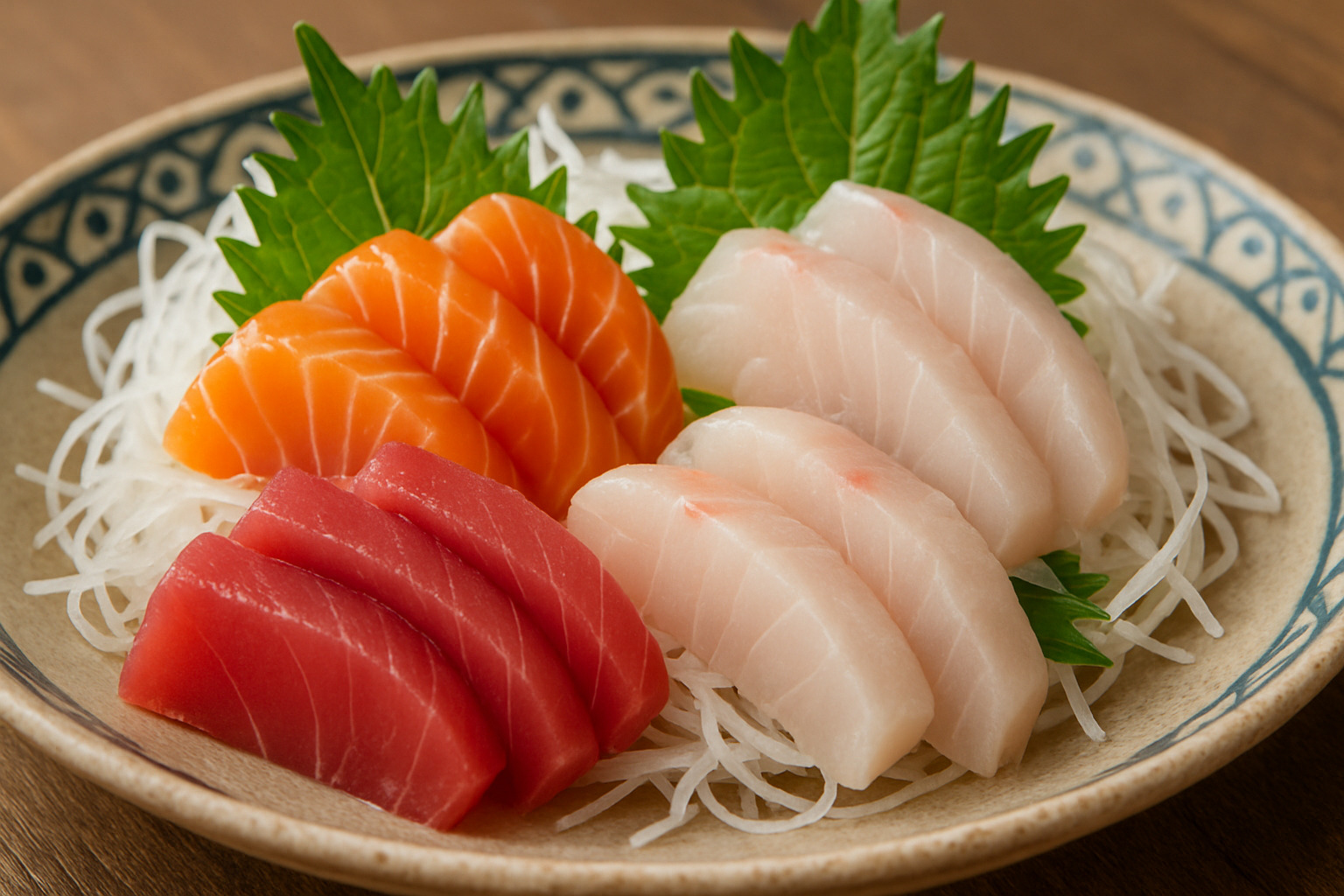
When you first encounter sashimi in Japan, you might wonder why such simple-looking fish comes with so many accompaniments. The truth is, every element on that plate has been carefully chosen to improve your experience over centuries of culinary refinement.
Traditional *sashimi presentation follows a beautiful logic* that combines visual appeal with practical function. The fish sits gracefully on a bed of shredded daikon radish, with bright green shiso leaves providing striking color contrast. This isn’t just for show – the daikon’s gentle spiciness cleanses your palate between different fish types, while those aromatic shiso leaves add subtle complexity to each bite.
A proper *sashimi serving typically includes 6-9 pieces, each weighing about 15-20 grams. This portion size allows you to savor the experience without overwhelming your palate, especially when *sashimi appears as the opening course in a traditional meal.
The art of eating *sashimi properly is surprisingly simple* once you understand the basics. Pick up each piece with chopsticks, lightly touch one edge to your soy sauce (never drown the entire piece), and eat it in a single bite. The goal is to taste the fish first, with the soy sauce providing gentle improvement rather than masking those delicate ocean flavors.
Traditional Plating & Condiments
Every garnish on your *sashimi plate serves a specific purpose* beyond looking pretty. The daikon radish provides that crisp, slightly spicy bite that resets your taste buds. Shiso leaves offer an herbal note that complements the fish’s natural sweetness.
Other traditional accompaniments you might encounter include wakame seaweed for its chewy texture and oceanic depth, cucumber cups that can hold extra wasabi, and thin carrot julienne that adds natural sweetness and vibrant color. Sometimes you’ll find citrus segments like sudachi, which provide bright acidic notes that make the fish taste even fresher.
Real wasabi deserves special attention. Unlike the green paste you might know from takeout sushi, authentic wasabi root provides complex heat that improves rather than burns. Place a tiny amount directly on each piece of sashimi rather than mixing it into your soy sauce, which dilutes both flavors.
Gari (pickled ginger) acts as your palate’s reset button between different fish varieties. Its sharp, sweet flavor clears your taste buds, allowing you to fully appreciate the subtle differences between, say, buttery salmon and clean-tasting sea bream. Think of it as changing courses rather than eating it with every bite.
For something different, try ponzu sauce as an alternative to plain soy sauce. This citrus-improved dipping sauce combines soy sauce with dashi, rice vinegar, mirin, and fresh citrus juice, creating a brighter, more complex flavor profile that works beautifully with delicate white fish.
Dining Etiquette & Pairings
Timing matters tremendously when enjoying *sashimi.* In traditional Japanese dining, sashimi always appears first, before stronger flavors can overwhelm your palate. This isn’t just tradition – it’s practical wisdom that allows you to detect the subtle quality differences that make great sashimi special.
The right beverages can lift your *sashimi experience* without competing with those delicate flavors. Clean, dry sake complements without overpowering, while green tea provides gentle palate cleansing between courses. Light beer works surprisingly well with oily fish like salmon, and crisp white wines like sauvignon blanc offer acidic contrast that makes the fish taste even fresher.
Soy sauce etiquette prevents waste and maintains flavor balance. Pour only what you’ll actually use – leaving excess soy sauce is considered wasteful in Japanese culture. Remember to dip the fish lightly rather than soaking it, and resist the urge to mix wasabi directly into your soy sauce dish.
The order you eat different fish types can make or break your sashimi experience. Start with lighter, more delicate varieties like flounder or sea bream, then progress to richer fish like salmon or tuna. Save the most intense flavors like uni (sea urchin) or strongly flavored fish for the end, when your palate is ready for those bold tastes.
Understanding these traditions helps you appreciate *sashimi the way generations of Japanese diners have* – as a meditation on freshness, seasonality, and the ocean’s natural gifts. Once you master these basics, you’ll find yourself truly tasting the fish rather than just eating it.
Sustainability, Health & Modern Adaptations
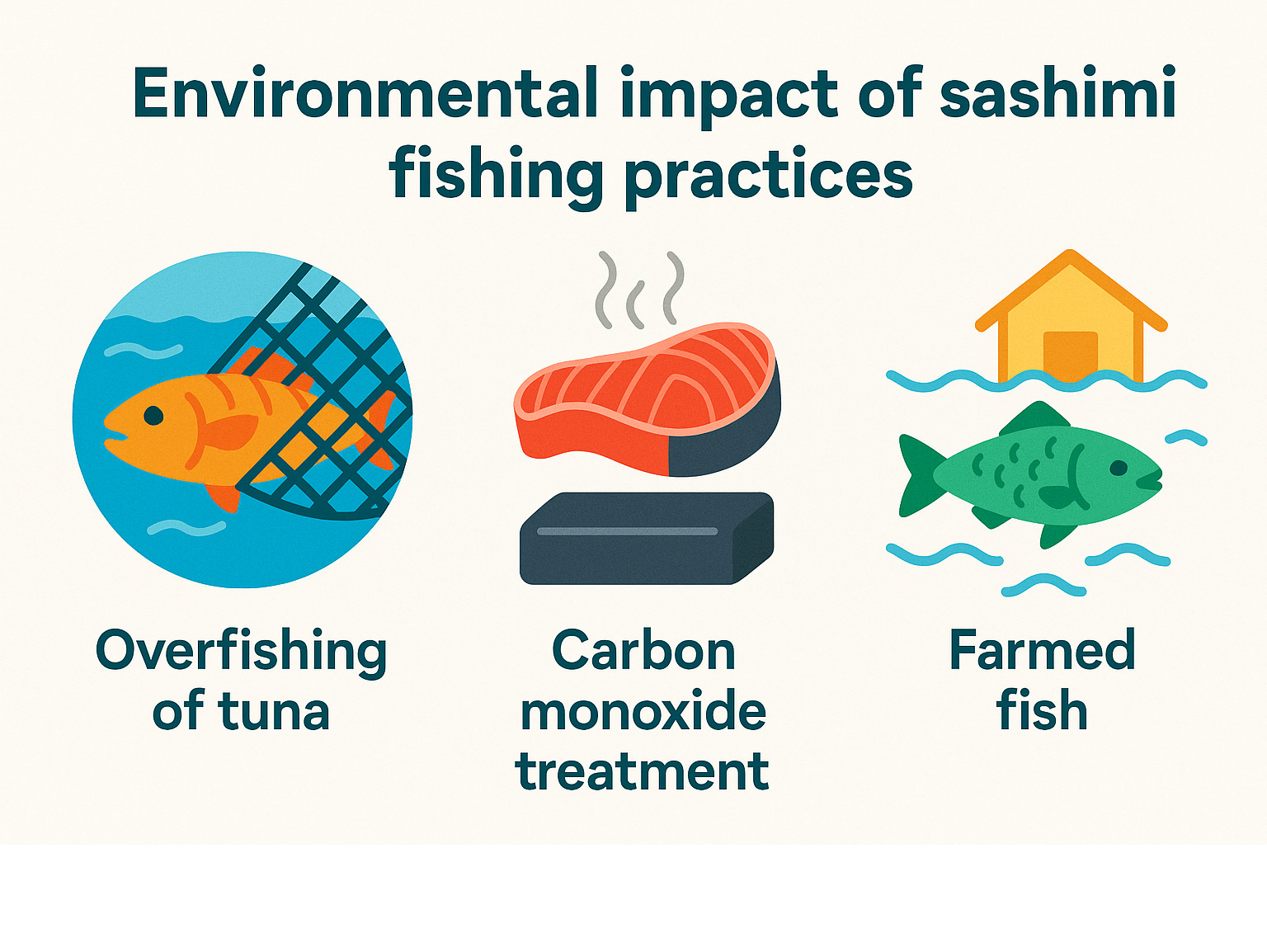
The world of sashimi is changing rapidly as environmental concerns reshape how we think about raw fish dining. Bluefin tuna, once the undisputed king of sashimi, now faces potential extinction due to decades of overfishing. This crisis has forced restaurants and home cooks alike to explore new options while preserving the artistry that makes sashimi so special.
Farm-raised salmon has quietly revolutionized *sashimi safety.* Studies consistently show that properly managed aquaculture eliminates the parasite risks commonly found in wild salmon, making farmed varieties actually safer for raw consumption. Norwegian salmon farming techniques have become the gold standard worldwide, proving that sustainable practices can improve rather than compromise quality.
The industry’s response to these challenges has sparked fascinating innovations. Carbon monoxide treatment allows suppliers to maintain that appealing bright red color in tuna even as freshness declines, but this practice raises serious safety concerns for sashimi lovers. Meanwhile, vegetarian alternatives like thin-sliced konnyaku root and delicate yuba tofu skin offer plant-based diners authentic sashimi experiences without compromising traditional presentation.
Nikkei fusion cuisine demonstrates how sashimi techniques can evolve while honoring their roots. This Japanese-Peruvian blend applies traditional knife skills to local ingredients, creating dishes that feel both familiar and excitingly new. These adaptations show that sashimi isn’t frozen in time – it continues growing and adapting to modern tastes and concerns.
For readers interested in making more conscious food choices, exploring Japan’s culinary traditions offers insights into how respect for ingredients can guide sustainable eating practices.
Staying Safe While Enjoying Sashimi
Japan’s own regulations tell the story of evolving food safety understanding. Since July 2012, the country has banned raw beef liver sashimi at restaurants due to serious Hepatitis E and E. coli risks. This decision shows that even centuries-old traditions must adapt when science reveals new dangers.
Mercury concerns vary dramatically between fish species. Large predators like tuna accumulate higher mercury levels throughout their lives, making moderation important for regular sashimi enthusiasts. Smaller fish such as mackerel and sardines typically contain much lower levels while still delivering exceptional raw fish experiences.
Allergen awareness becomes critical with shellfish *sashimi.* Sea urchin, salmon roe, and various mollusks can trigger severe reactions in sensitive individuals. Cross-contamination during preparation adds another layer of risk, making clear communication with servers essential for safe dining.
Smart sourcing addresses multiple concerns simultaneously. Choosing suppliers who follow proper freezing protocols, maintain strict cold chains, and provide detailed handling documentation protects against parasites, bacterial contamination, and quality issues all at once. This approach transforms sashimi from a risky indulgence into a calculated pleasure.
Special populations need extra caution. Pregnant women and people with compromised immune systems should avoid sashimi entirely, as even properly prepared raw fish carries bacterial risks that healthy adults typically handle without problems.
Eco-Friendly Choices & Seasonal Alternatives
Local catch often provides the best combination of sustainability and quality. Coastal communities offer seasonal sashimi opportunities that don’t require long-distance shipping, reducing environmental impact while often delivering superior freshness. These regional specialties frequently cost less while supporting local fishing families.
MSC certification helps identify responsible suppliers. While not every excellent sashimi fish carries Marine Stewardship Council labels, these certifications indicate fishing practices designed to protect long-term ocean health. Supporting certified operations encourages broader industry adoption of sustainable methods.
Seasonal eating aligns with natural rhythms and often rewards you with peak flavors. Summer brings exceptional ika somen (squid cut into noodle-thin strips), while winter offers premium buri (mature yellowtail) with rich fat content that makes cold months worthwhile.
Alternative species reduce pressure on threatened populations. Instead of always reaching for bluefin tuna, consider albacore, skipjack, or other varieties that provide outstanding sashimi experiences while supporting more sustainable fishing practices. These choices prove that environmental responsibility doesn’t require sacrificing culinary pleasure.
The future of sashimi depends on balancing tradition with innovation, ensuring that future generations can experience this remarkable art form while protecting the oceans that make it possible.
Frequently Asked Questions about Sashimi
What makes fish “sashimi-grade”?
Here’s something that might surprise you: “sashimi-grade” isn’t actually a regulated term. It’s more like a promise from your fish supplier that they’ve followed specific safety protocols to make their fish safe for raw consumption.
The real magic happens in the freezer. The FDA requires fish destined for sashimi to be frozen at -35°C for 15 hours or -20°C for 7 days. This isn’t about keeping fish fresh – it’s about killing parasites that could make you seriously ill. Think of it as a necessary step that transforms regular fish into sashimi-ready fish.
What really matters is your supplier’s reputation and handling practices. The best fish vendors can tell you exactly when their fish was caught, how it was processed, and what freezing protocol was used. They’ll show you documentation and answer your questions without hesitation.
Visual inspection tells you more than any label ever could. Look for fish with bright, clear eyes that seem almost alive. The flesh should spring back when you press it gently, and the smell should remind you of a clean ocean breeze – never “fishy” or sharp.
Can I use supermarket salmon for sashimi?
We really don’t recommend using regular supermarket salmon for *sashimi.* Here’s why: that beautiful piece of salmon has been on quite a journey. It’s been gutted, skinned, packaged, and passed through multiple hands before reaching your grocery cart. By the time you see it, there’s no way to verify its freshness or handling history.
That appealing pink color might be fooling you too. Many supermarkets use carbon monoxide gassing to keep salmon looking fresh and rosy, even when it’s past its prime. It’s like makeup for fish – it looks good but hides what’s really underneath.
If you absolutely must use supermarket fish, choose varieties that are clearly labeled as previously frozen. Then refreeze them yourself following FDA protocols – that means 7 days at -4°F. But honestly, you’re better off finding a specialty fishmonger who understands sashimi requirements.
The safest route is finding suppliers who work with sushi restaurants. These vendors understand the stakes and maintain the cold chain and handling standards that make sashimi safe and delicious.
Are there vegetarian or cooked versions of sashimi?
Traditional *sashimi actually includes some cooked preparations, which surprises many people. Octopus *sashimi is almost always boiled first because raw octopus is incredibly tough. The cooking makes it tender while maintaining the clean, precise presentation that defines sashimi.
Tataki represents another traditional “cooked” *sashimi style.* The fish gets quickly seared on the outside while staying raw inside, then sliced using traditional sashimi techniques. It’s like getting the best of both worlds – a hint of cooked flavor with that silky raw texture.
Vegetarian *sashimi alternatives follow the same artistic principles* with plant-based ingredients. Yuba (tofu skin) slices beautifully and accepts traditional seasonings like soy sauce and wasabi. Konnyaku root provides an interesting texture that’s surprisingly satisfying when prepared with proper knife techniques.
Some modern preparations blur traditional boundaries. Shimesaba (lightly cured mackerel) uses salt and vinegar to “cook” the fish without heat. It maintains sashimi’s texture and presentation while creating unique flavors through the curing process.
The key is respecting the technique and presentation, regardless of whether the main ingredient is raw, cooked, or plant-based. The precise knife work, thoughtful plating, and traditional accompaniments are what make something truly sashimi-style.
Conclusion
Sashimi represents something magical in the culinary world – it’s the art of making something extraordinary from pure simplicity. This isn’t just about slicing raw fish; it’s about centuries of Japanese wisdom that teaches us to honor ingredients in their most natural state.
The future of raw fish dining looks bright, even as we face real challenges. Climate change and overfishing have forced us to think differently about sashimi, but this has sparked incredible innovation. We’re seeing sustainable fish farming reach new heights, chefs exploring seasonal alternatives, and even plant-based versions that respect traditional techniques while protecting our oceans.
Your *sashimi trip doesn’t end here.* Whether you’re planning to try that intimidating omakase menu or attempting your first home preparation, every expert started exactly where you are now. The key is respecting the process – invest in quality fish, learn proper techniques, and never rush the experience.
What makes *sashimi truly special is how it connects us* to something larger than ourselves. Every perfectly cut piece tells a story of ancient fishing villages, dedicated craftspeople, and the endless creativity that emerges when we truly understand our ingredients. It’s food that demands your full attention and rewards it generously.
The world of *sashimi welcomes curious food lovers* with open arms. Start simple with familiar fish like salmon or tuna, then gradually explore more adventurous options as your palate develops. Each new variety teaches you something different about texture, flavor, and the incredible diversity our oceans provide.
For those ready to dive deeper into authentic culinary experiences beyond your kitchen, our World Cuisine Exploration guide reveals how to find genuine traditional dishes and the stories behind them. At The Dining Destination, we believe that understanding foods like sashimi transforms ordinary meals into cultural bridges that connect us to places and people around the globe.
Your *sashimi journey starts with a single perfect slice* – clean, fresh, and full of possibility. The techniques you’ve learned here will serve you well, whether you’re impressing dinner guests or simply treating yourself to something special. Welcome to a culinary tradition that turns simplicity into art, one careful cut at a time.

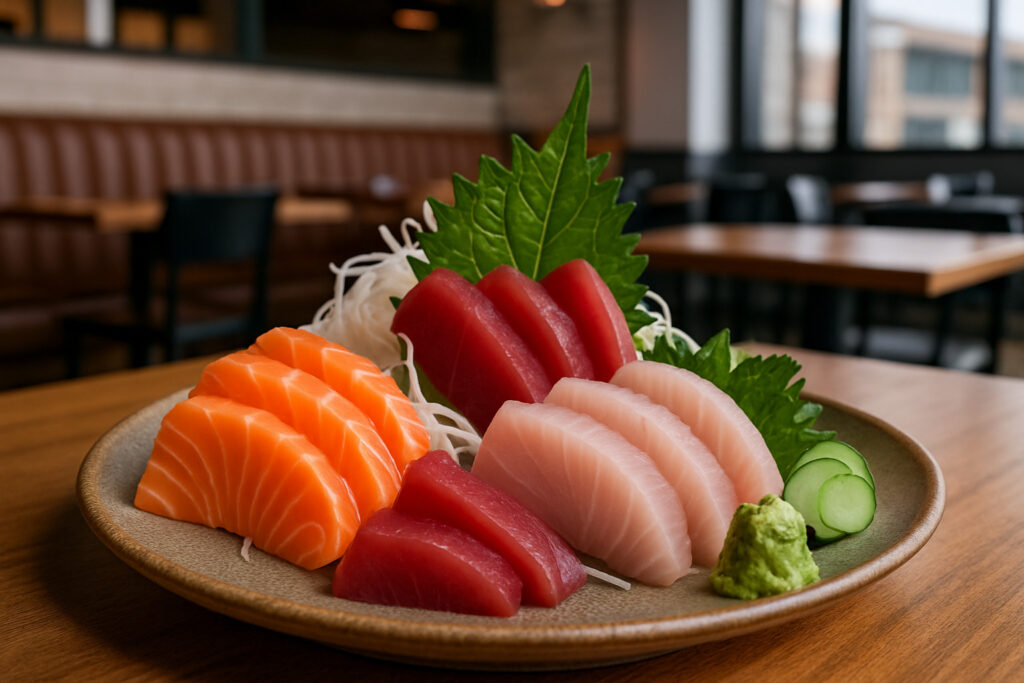







2 thoughts on “Beginner’s Guide to Sashimi: What It Is and How It’s Enjoyed”
Pingback: How to Make a Delicious Salmon Recipe on a Budget - The Dining Destination
Pingback: Everything You Need to Know About Tahini - The Dining Destination
Comments are closed.